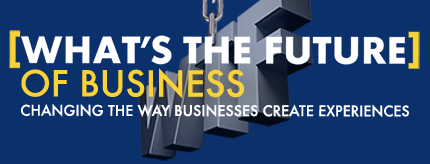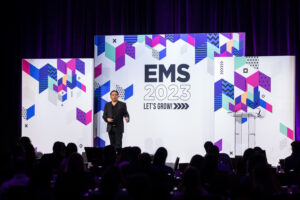The Technology of Us
I’ve been in the technology business for a long time and what I can tell you is this: Technology enables us to invent new products and services at rates that humans never before experienced. Whatever the next big thing is in tech doesn’t matter as much as the fact that anyone today has the power to disrupt entire industries with a single, smart idea.
In fact, resilient companies, whether they’re startups or they merely acting like one, will intentionally break their business models in anticipation of what customers want and need.
Look at the “sharing economy” — companies like Uber, Airbnb, TaskRabbit and other services that allow people to rent or share their cars, homes or skills has taken off because technology empowered a few upstarts to take on the taxicab and hotel industries. In fact, mobile, social and geo-location technology have made using, renting or borrowing these products and services as easy as the Internet once made buying them. Yet it’s more than just an idea driving all that — evolving consumer values and aspirations have as much to do with this phenomenon as technology. So what does the rise of the sharing economy say about businesses today? That there is a massive disconnect between what consumers want and what companies are delivering. That anyone with vision and empathy can upend entire industries.
That’s one reason why I believe we’re on the cusp of a new wave of rapid creative destruction in business unlike anything we’ve seen before — a form of Digital Darwinism not unlike the forces that have shaped human evolution. The companies that emerge from this tumult won’t be the “living organisms” that businesses have been called — ones that simply learn, adapt and eventually die. Instead of fiercely protecting their business models, they will tear them down and build new ones. This is creative destruction as an intentional strategy, rather than creative destruction as it has long been defined — as an economic threat. To succeed means thinking about customers differently, as groups of connected people and not simply demographics. It requires a level of leadership that can see something others don’t or find inspiration in what others feel or hope to feel. These traits — not the technology itself — are what will define the most resilient companies in the years to come.
Plugging into your customer’s ‘ego-system’
Netflix is held up as an example of a company willing to risk cannibalizing itself for the future. When the company saw a decade ago that DVDs were rapidly becoming obsolete, it built a thriving online streaming business to replace it. Now it is pushing into content origination with shows like “House of Cards.” That’s not a bad idea, obviously, but it’s not sufficient for the level of creative destruction I’m talking about.
To be successful, companies will require more than just a focus on scale, profit and the next big thing. It requires true empathy for what your customers are thinking and an ability to identify what they want or need even before they do. Apple consistently did it with the Mac, iPhone and iPad. Twitter did it with the 140-character message. Airbnb is doing it with homes. WhatsApp did it with data messaging. The challenge is that there is no one-size-fits-all solution. You have to see your customers for who they are becoming, not just who they are today.
My generation was taught to follow a linear path to success: go to school, get a job, own a home, buy 2.3 cars, have children and save for retirement. Young consumers today think differently. They’re more connected, empowered and concerned with what I call their own “ego-system.” With technology’s help, people can create a world in which they are at the center of their own universe and brands are in orbit around them, not the other way around. Eventually, customers are going to expect products or services in whatever form they want them. If a company can’t deliver on that, they’ll rely on their connections to find a company that can.
Consumer values are changing, too. Buying a house is no longer the American dream. Consumers may not even need a car. And when they walk into Starbucks, they’re looking for more than a decent cup of coffee. They want an overall satisfying experience — and this means more than just chatting with a friendly barista. They want to feel connected to Starbucks or any other company they deal with in the same way they feel connected with their friends or peers.
Crossing the experience divide
Behind the rise of Uber and Airbnb is a collective sense that, with technology, we are building a better community. No matter where we go with new technology, whether it’s social, mobile, wearable or Big Data, it won’t matter until companies learn to temper their profit goals with empathy and look at the bottom line as part of a larger mission, doctrine or ethos. Simply put, you’ve got to care about your customer and make the people around you care, too. Airbnb doesn’t actually stock inventory. Uber doesn’t technically employ a fleet of cars. They built a seamless platform for connecting people with people to deliver new experiences.
In the case of Uber, taxi companies could have changed their business model all along, but didn’t. What this demonstrates is that if you do not disrupt, someone else will disrupt for you. And, Uber’s not done. The company recently changed its tagline from “Everyone’s private driver” to something much more disruptive: “Where lifestyle meets logistics.”
Start by defining the experience you want your customers to have. How do you want them to feel? What should they share? Define it. Build it.
Often, what customers are likely to share is not in alignment with your brand promise today. What you say your brand is and what others may share are different. To what degree? Well, that’s what determines what I call the experience divide. In a sharing economy, it’s not just places and things that we share. We depend on the shared experiences of our peers to help us make informed decisions or investments. If we’re not creating the types of experiences we want people to have and share, we’re simply reacting to them.
The most obvious example of it is our propensity to share negative experiences. People vent to get resolution to feel better. It’s cathartic. Social and mobile amplify these experiences, making them more influential than ever before. But what about the positive experiences? They feel good to express outwardly, too, though we’re not innately inclined to share them. Even so, it’s in the business’s best interest for consumers to share these positive experiences, because we know that they define the ultimate moment of truth — the moment when the consumer enters into a partnership with the brand.
This is where positive conditioning comes in. If the future of a company’s brand is dependent on shared experiences, it is important to adopt positive reinforcement and positive psychology in order to create shareable, meaningful moments. This means that companies must invest in the consumer as well as in these positive moments. If I, for example, value you as a customer, but I ask you in return to share a great experience you’ve had with my brand, I should have a loyalty program that rewards you for your advocacy. This new strategy for loyalty and advocacy determines the future of the brand. It’s not going to be defined by the company, but by everyone.
Embrace the change
The creative destruction that I’m describing won’t be easy. As humans, we tend to fear change. As we grow, we develop neural pathways that dictate how we respond to life events, and these neural pathways become harder to tear down and recreate as we age. Change can be intensely uncomfortable at first, especially when nothing appears to be broken.
Companies, too, develop neural pathways. They identify and develop products, processes and philosophies that allow them to flourish at first but later cause stagnation. History is rife with examples of businesses that built great products or services — usually by challenging the status quo — only to become paralyzed by their success. Think Blockbuster, BlackBerry or Kodak. Kodak invented the first digital camera, but didn’t change the prototype into an actual product. Why? For fear of eroding its film business. A “Kodak moment” no longer suggests capturing a moment to be remembered and shared; it refers to any business that misses new opportunities to disrupt itself.
The root problem is that most companies are built on a platform of critical thinking — built to keep things from going wrong, not to try to break things apart. When technology pushes us to move forward faster and faster, the first reaction is usually to go back before moving forward. Creative disruption becomes a business strategy to either invest in or acquire the very things you feared, rather than simply protecting what it is you have.
Creative disruption at the rate I’m describing requires a different kind of business leader than what we see today. Managers are great at running and growing a business, but they’re not likely to break new ground. Future business leaders will develop a strong sense of urgency, and they’ll be able to sell that need for immediate change to other stakeholders.
I may not be able to predict what technology we’ll be using 5, 10 or 20 years from now. But I can tell you this: If there’s one thing I’ve learned as a digital analyst, it’s that the future is going to happen to you or it’s going to happen because of you.
And guess what? The future is happening right now.
The full version of the essay above is available here (complete with videos!).
Get the ebook!
If automation was the mantra for technology to date, is humanization the calling for technology in the future? The Technology of Us, a new ebook, explores this question from the perspective of top intellectuals, scientists, designers and business innovators. This collection of essays and interviews demonstrates how technology is pushing humankind into a new stage of evolution, with as many massive implications for modern business as for our individual lives. If you want a peek at the future of human innovation, this selection of stories will prove to be essential reading.
I’m proud to be part of this amazing lineup of contributors that includes George Lucas, Don Tapscott, Don Peppers, Doc Searls, Rachel Armstrong, Janine Benyus, Erik Brynjolfsson among several other amazing minds.
You can read it online or offline via iBooks, Kindle and Nook.
Connect with me… Twitter | LinkedIn | Facebook | Youtube | Instagram | Pinterest








The best articles are the ones that take forever to finish reading because every sentence makes you stop and think. This is one of those articles. Essential reading for every entrepreneur.
Wow Sherry. You made my day!
As I tried to compose a comment I read Sherry Emerson’s. Nothing further need be said. Great description of what I just felt Sherry. Thanks.
Thank you. Since Sherry made my day today. Sheila, I’ll carry your comment over to make my day tomorrow. 🙂
Still thinking about some of your points. May have to take another read so I thank you, sir.
Same! I’m suddenly investigating everything Brian has written & already sharing with my management team. Ben A. Smith is my hero for sharing Solis on Twitter.
Ben is my hero too!
Love that Sherry – would be interested to hear how the management team responds (positive/negative/neutral) to new ideas!
There’s so much in this blog post that I feel I could respond to. As Sherry and Sheila pointed out, it’s a great piece that inspires immediate reflection with each period.
I am especially struck by the idea of the loyalty program to encourage clients/customers to share positive experiences with others. It’s not necessarily a new idea, but it’s one that even very traditional businesses should leverage.
I’m thinking, for instance, of my local pizza place. Big Daddy’s Pizza in Northeast Philadelphia. Great food, huge menu, and consistent service. I spend a lot of money with their business. But I definitely think they’re missing an opportunity to make more money with me, as well as to gain new customers, by not embracing a loyalty program of some kind. If they offered me discounts on specific menu items, on 1 purchase out of 10 or even 15% off for posting about them on social media, I’d purchase even more often and share their brand with my little world. And, honestly, if a pizza place came along offering such a program, I’d be likely to switch over.
Even — or perhaps especially — Mom-and-Pop businesses need to push the boundaries and make the future happen because of them, not to them.
Rosella LaFevre, Marketing Consultant
http://www.rosellalafevre.com